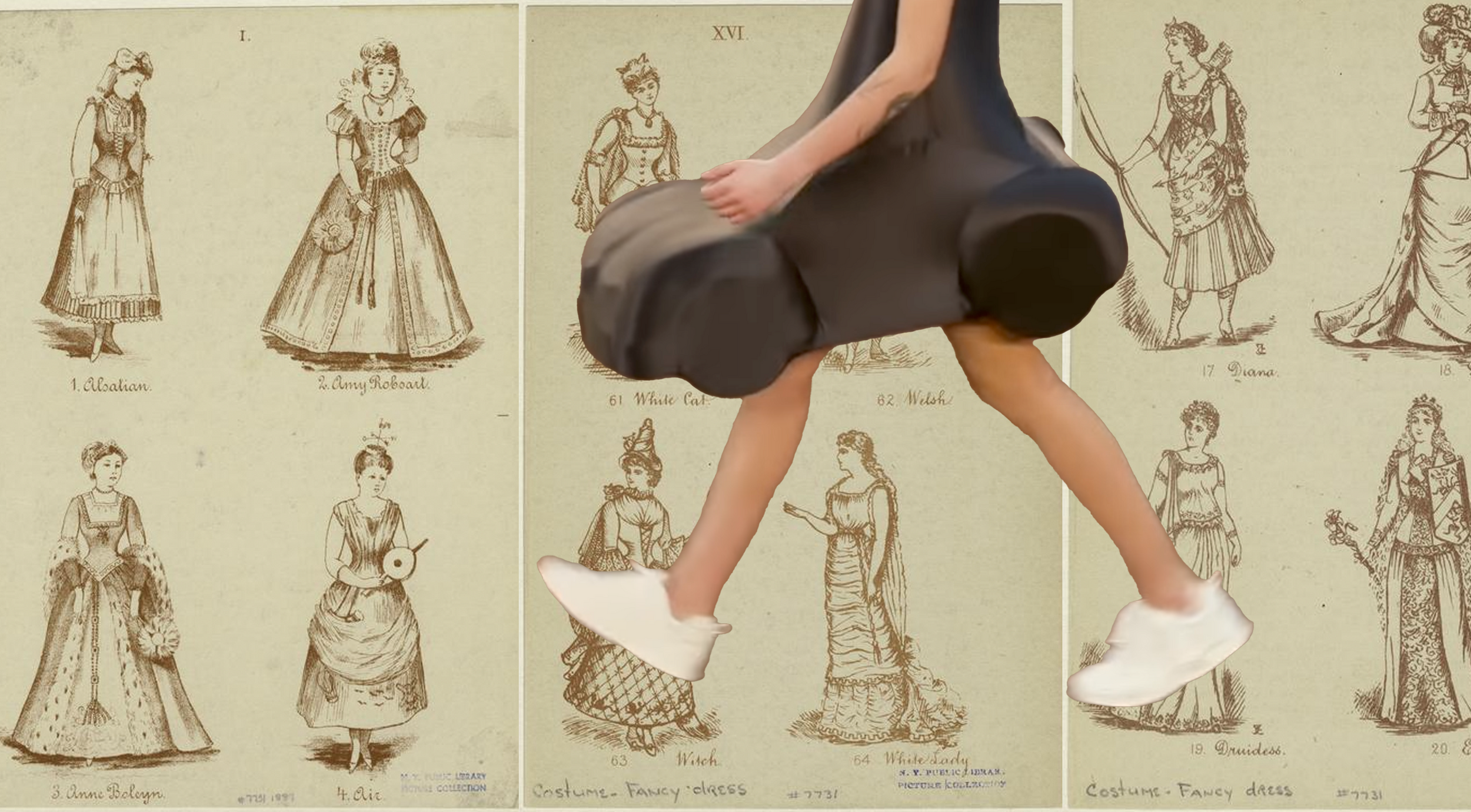The Princess and the Frog: What Makes a Costume a Costume?
We like to believe that the clothes we wear say something about us. To understand what they actually convey, we must ask a fundamental question—what’s the difference between a costume and an outfit?

“Princess Diana Outfit Season is Finally Here,” proclaimed an article my sister sent me last month. The magazine–Town & Country–was not recommending gowns or tiaras for everyday wear. Instead, the author wanted me to know that a fashion-forward autumn 2023 wardrobe should include cycling shorts and a Harvard sweatshirt, as repeatedly worn by the princess during sessions with her personal trainer. Also, vitally, sneakers with tall white socks. “Crew socks are replacing the no-shows that have been de rigueur for years,” explained the article. For Diana fans, the fashion stars have aligned—elements of the princess’ 1980s exercise gear are back. Now I can jog through the neighbourhood in a slouchy sweatshirt, secure in the knowledge that my outfit is both in tribute and on trend.
This was not, to be clear, Halloween advice. Town & Country was talking about a Princess Di outfit; not to be confused with a Princess Di costume. “Grab a Gown and Tiara,” a fall 2017 headline on Popsugar advised. “Here’s How to Pay Homage to Princess Diana This Halloween.” The banner look was a tiara and a cascading pink dress with gauzy bows at the shoulders. Princess Di wigs start at $18.99 on Amazon.
What makes one of these ensembles an outfit (Harvard sweatshirt and bike shorts) and the other a costume (gown and tiara)? An outfit is supposed to be a plausible entry in the lexicon of our ordinary wear; when someone says to me, “I like your outfit,” they are praising how I set myself apart within the (sometimes stifling) parameters of “normal” clothing. A good costume, on the other hand, signals its departure from these parameters. If I show up at a costume party in something too close to the fashion of the day, it looks like I haven’t dressed up at all.
A costume and an outfit also differ in the degree of referentiality—the more specific the thing being invoked, the more the look is a “costume.” But all clothes reference something, whether as nebulous as “woman” or as narrow as “New York graphic designer.” In playing the role of myself, I dress the part by choosing outfits that convey a set of attributes I want people to associate with me. At this time of year, there will always be those who demur from joining the Halloween festivities on the grounds that they feel silly in costume. But on the level of social and emotional risk, putting together an outfit seems to me a much higher stakes proposition—an outfit is a costume meant to convince people they are seeing the real me.
*
“Whan a synner commeth to the custome of syn, than he falleth to contempt,” wrote the monk William Bonde in 1526. “Custume” came into English from French in the 1200s, and at the time, it meant a widely accepted mode of behaviour or a habitual practice—what we now mean by “custom.” Over time, a similar word came to be applied to what one habitually wore. In 1925, P.G. Wodehouse had Bertie Wooster say this of his butler’s vendetta against his mustache: “While there’s no doubt that in certain matters of dress Jeeves’s judgement is absolutely sound and should be followed, it seemed to me that it was getting a bit too thick if he was going to edit my face as well as my costume.” When putting on a costume, we imitate a custom—to make the imitation recognizable, we don the customary dress of someone (or something) else.
“To outfit,” by contrast, originally meant to gather the equipment needed for an expedition, often an ocean-going one (the meaning persists in the names of woodsy retailers like Algonquin Outfitters). “An outfit” came to refer to the equipment itself, and by the 1850s, North Americans were using the phrase to mean a person’s sartorial equipment—their clothes. This would seem to speak to an outfit’s aspirational quality; when outfitted, we are dressing for bravery, heading out to do battle with the wayward elements. Paradoxically, if wearing a gentleman’s evening costume indicates the wearer’s facility with the social codes of the time, wearing an outfit suggests someone venturing beyond the safe precincts of the usual.

In present-day usage of the word, outfits imply a certain degree of risk because they are by nature allusive, while costumes are literal. An outfit suggests precedents, invokes mood or season, hints at personality traits. But the unspoken nature of these codes means attempting to harness them can result in saying what we don’t mean. I wore a camel-coloured cape to meet a friend the other day, and halfway through our coffees I took off a black cardigan I had layered underneath. “Before, you looked like you had just stepped out of your chrome-and-glass condo,” my friend said. But now, in a cape with bare arms, “you look like you’re on your way to a Renaissance fair to sell your jam.”
In 1963, Roland Barthes published the ur-text of “dress studies,” The Fashion System, in which he analyzed the semiotics of clothes as discussed in women’s fashion magazines. The “mother tongue” of clothes, he wrote, is the technological mode—the way in which they are manufactured. The garments we see are only “instances of speech.” “‘Seeing’ a real garment,” Barthes wrote, “even under privileged conditions of presentation, cannot exhaust its reality, still less its structure; we never see more than part of a garment, a personal and circumstantial usage, a particular way of wearing it.” Asking where a skirt or jacket was made, from what materials, by whom, and through what mechanical means tells us more (for Barthes) about what the item is than simply assessing what it looks like on a particular wearer. We see only distorted fragments. What clothes look like is perhaps the least of what they are.
My sister comes up a lot when I think about clothes. Because so much of my wardrobe is made up of her hand-me-downs, I often feel that I am dressed “as” her. My sister is two years older than I am, and if I never quite succeeded in becoming her, it was not for lack of trying. In figuring out what kind of person I was or wanted to be, I started out by taking my cues from her. The most aspirational items in my closet are generally those that were once hers, and seem most appropriate for places I never go, to impress people I am never with—a skirt for a garden party, a blazer for a hiring committee. One silk dress, patterned with hummingbirds, wouldn’t constitute itself into the shape of a dress on me at all—I couldn’t make its speech coherent.
Costumes avoid some of these pitfalls because their meanings are more blunt. If I am dressed as the Eiffel tower or a stained glass window, I know what I’m doing. Perhaps the appeal of costumery is not only in the enhanced freedom to express oneself, but in the release from the social demand for more subtle decoding. “When an individual enters the presence of others, they commonly seek to acquire information about him or to bring into play information about him already possessed,” wrote Erving Goffman in his 1956 book The Presentation of Self in Everyday Life. One of the early sociologists to discuss the construction of self as a performance analogous to theatre, Goffman posited dress as a way to send a series of signals about who we are in the world. If the self is always a type of performance, all clothes are costumes.
During the pandemic, many noted that fashion became more surreal—untethered from our usual social realities, notions of the self turned abstract. At Paris Fashion Week in the spring of 2022, the Spanish luxury brand Loewe sent a model down the runway in a metallic silver dress with the hemline of a three-dimensional car, and another in a black dress with what looked like beige water-balloons tucked into the folds. The fashion critic Sarah Mower wrote, “in times when reality becomes outrageous and nonsensical, it’s only logical that fashion should start to reflect illogicality.”
At one point, with park hangs as the only social option, a friend and I started meeting up dressed as birds. Just a swan and a flamingo playing ping-pong, NBD. Without the ordinary social guardrails in place, it didn’t seem to matter whether I was costumed as a bird or as a woman named Linda Besner. On TikTok, “clowncore” became a thing. Even as more conservative social codes have returned with the world opening up again (the most recent Paris Fashion Week emphasized Succession-inspired “quiet luxury” and the return of neutrals), an undercurrent of surrealism persists—and, perhaps, a recognition that the self is a more elastic, less known quantity than we pretend. (Over the past decade, the popularity of cosplay has probably helped this idea along; it’s become unremarkable to see people walking down the street dressed as anime characters.) Influencers like Hamilton’s Sara Camposarcone continue inventing ensembles like her recent “frog” look: slime-coloured boots with separated toes, an enormous realistic frog-shaped handbag, worm earrings, and a lime-green tutu. “I’m the princess AND the frog!” she cheered on TikTok.
*
The other day, I sat at a sidewalk café and watched the costumes go by. A woman in a gauzy black dress with silver polka dots, her air of dreamy sophistication undermined by the twelve-pack of toilet paper she carried under one arm. A teenager with blue hair and a backpack worn so low it called to mind a bustle.
In The Second Sex, Simone de Beauvoir wrote: “the least sophisticated of women, once she is dressed, does not present herself to observation; she is, like the picture or the statue, or the actor on the stage, an agent through whom is suggested someone not there—that is, the character she represents, but is not.” Maybe none of us are capable of locating ourselves inside our clothes. But to me, regarding the clothes of others is a way of imagining what it’s like to be someone else. Whether the character being communicated corresponds to some “authentic” self or even to the persona the wearer intends to present, what is visible are the materials for imagining the process of choosing. The wearer tries on, discards, tries on something else, before finally settling on the items in which they enter the scene. The stage implies the dressing room; perhaps our vulnerability is most keenly visible in the naturalist mode.





